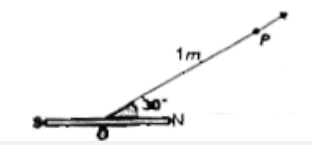if element ,25X+y has spain magnetric moment 1.732 B.M then:
number of unpaired electron =1
number of unparired electron =2
Y=4
Y=6
The correct Answer is:A, D
To solve the problem, we need to determine the number of unpaired electrons in the element 25Xy given that its spin magnetic moment is 1.732 Bohr magnetons (B.M).
1. Understanding the Magnetic Moment Formula:
The spin magnetic moment (μs) is given by the formula:
μs=√n(n+2)
where n is the number of unpaired electrons.
2. Setting Up the Equation:
We know that the magnetic moment is 1.732 B.M. Therefore, we can set up the equation:
√n(n+2)=1.732
3. Squaring Both Sides:
To eliminate the square root, we square both sides:
n(n+2)=(1.732)2
Calculating (1.732)2:
(1.732)2=3
Hence, we have:
n(n+2)=3
4. Rearranging the Equation:
Rearranging gives us a quadratic equation:
n2+2n−3=0
5. Factoring the Quadratic:
We can factor this quadratic equation:
(n+3)(n−1)=0
This gives us two possible solutions for n:
n+3=0⇒n=−3(not valid since n cannot be negative)
n−1=0⇒n=1
6. Conclusion on Unpaired Electrons:
Thus, the number of unpaired electrons n is 1.
7. Identifying the Element:
The atomic number 25 corresponds to the element Manganese (Mn). The electronic configuration of Mn is:
Mn: 1s22s22p63s23p64s23d5
Manganese has 5 unpaired electrons in its ground state.
8. Determining the Value of y:
To achieve 1 unpaired electron, Mn must lose 4 electrons. The electrons will be removed from the 3d subshell first due to its higher energy compared to the 4s subshell. Thus, the new configuration after losing 4 electrons will be:
4s23d1
This configuration has 1 unpaired electron.
9. Final Answer:
Therefore, the value of y is 4.
Summary:
The number of unpaired electrons is 1, and the value of y is 4.
The spin magnetic moment (μs) is given by the formula:
μs=√n(n+2)
where n is the number of unpaired electrons.
We know that the magnetic moment is 1.732 B.M. Therefore, we can set up the equation:
√n(n+2)=1.732
To eliminate the square root, we square both sides:
n(n+2)=(1.732)2
Calculating (1.732)2:
(1.732)2=3
Hence, we have:
n(n+2)=3
Rearranging gives us a quadratic equation:
n2+2n−3=0
We can factor this quadratic equation:
(n+3)(n−1)=0
This gives us two possible solutions for n:
n+3=0⇒n=−3(not valid since n cannot be negative)
n−1=0⇒n=1
Thus, the number of unpaired electrons n is 1.
The atomic number 25 corresponds to the element Manganese (Mn). The electronic configuration of Mn is:
Mn: 1s22s22p63s23p64s23d5
Manganese has 5 unpaired electrons in its ground state.
To achieve 1 unpaired electron, Mn must lose 4 electrons. The electrons will be removed from the 3d subshell first due to its higher energy compared to the 4s subshell. Thus, the new configuration after losing 4 electrons will be:
4s23d1
This configuration has 1 unpaired electron.
Therefore, the value of y is 4.
The number of unpaired electrons is 1, and the value of y is 4.
Similar Questions
If magnetic moment is zero the substance is diamagnetic.
If an ion of 25(Mn) has a magnetic moment of 3.873 B.M. Then oxidation state of Mn in ion is :
View SolutionAn oxide of an element X' having atomic number 23 has a magnetic moment of 1.732 BM. The oxidation state of X in the oxide is
View SolutionAn element belonging to 3dseries of modern periodic table has spin magnetic moment = 5.92 B.M in +3 oxidation state. Determine the atomic number of element.
View SolutionA compound of a metal ion MX+(z=24) has a spin only magnetic moment of √15B.M. . The number of unpaired electrons in the compound are
View SolutionOne unpaired electron in an atom contributes a magnetic moment of 1.1 B.M. Calculate the magnetic moment of Cr
View SolutionAn ion (Mna+) has the magnetic moment equal to 4.9 B.M What is the value of (a) :
View SolutionThe component of the magnetic field along the line OP at due to the point P due to the bar magnet of magnetic moment 1.732Am2 is

View SolutionA compound made up of two elements X and Y has an empirical formula X2Y. If the atomic weight of X is 10 and that of Y is 5 and the compound has a vapour density 25, find the molecular formula,
View SolutionYou are given the following two complex X and Y which are isomer of each other , X is Hg [Co(SCN)4]. It is further given that 'spin only' magnetic moment of X is found to be 3.78 B.M. and that of Y is 1.73 B.M. Then which of the following is correct ?
View SolutionIf A and B are two sets such that A∪B has 60 elements, A has 32 elements and B has 36 elements. Find the number of elements in A∩B.
View Solution
